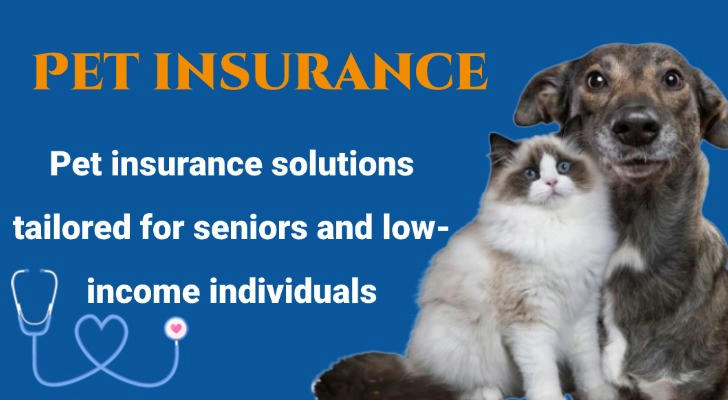🐾 Pets Need Health Insurance Too: Intimate Protection Designed for Seniors and Low-Income Families
No Age Restrictions | Stable Prices | Top Choice for Low-Income Families
Pet medical costs continue to rise in the United States, especially for those over 65 and low-income families, who often face the cost of medical care and insufficient savings. Pet insurance can help alleviate the burden of medical expenses and avoid unexpected expenses.

I. Why Pet Insurance is Important
Unexpected veterinary expenses can be a significant financial burden, especially for families on limited or fixed incomes. For example:
- Routine veterinary checkups: $100 to $300
- Emergency surgery: $2,000 to $5,000+
- Chronic condition care (e.g., diabetes, arthritis): $1,000+ per year
Without insurance, an unexpected visit or treatment for a chronic condition can cause long-term financial strain. Pet insurance can help you avoid unexpected high out-of-pocket expenses and ensure your pet receives timely treatment.
II. What does pet insurance typically cover?
Most pet insurance plans cover the following:
- Accident and Illness Treatment: Covers accidental injuries, illness diagnosis, and treatment.
- Surgery and Hospitalization: Covers expenses required for hospitalization and surgery due to major illness or accidents.
- Diagnostic Tests and Medications: Blood tests, X-rays, MRIs, and veterinary prescription medications.
- Preventive Care (Optional): Vaccinations, annual physicals, deworming, dental cleanings, etc.
- Behavioral Therapy (Some Plans): Professional treatment for behavioral issues.
These benefits help pet owners provide comprehensive medical support for their pets even when their finances are limited.
III. Where can I apply for pet medical and insurance assistance?
Low-income families and seniors with limited financial resources can apply for assistance with pet healthcare and insurance to ease the burden.
🏛Local Government Programs
Many cities and local governments offer pet support programs specifically for low-income individuals and those aged 65 and older, including:
- Vouchers for vaccines and basic care
- Low-cost mobile veterinary clinics
- Subsidized pet food and supplies
For example, the cities of Bowie, Maryland, and New York City have such programs. Consult your local health department or animal services agency for specific resources.
🏯Nonprofits
Some animal welfare charities provide grants and assistance, including:
- Brown Dog Foundation: Funding for emergency surgeries and treatments
- Paws 4 A Cure: Treatment grants for diseases without breed or age restrictions
- Banfield Foundation: Provides pet medical assistance specifically for low-income seniors
- Meals on Wheels Pet Program: Provides pet food and supplies to participants in the elderly meal delivery program
You can get specific application channels and eligibility information by searching "pet assistance + your zip code" or contacting local shelters and humane societies.
Even if the assistance does not cover all expenses, even some help can greatly reduce financial pressure and ensure that your pet is cared for in a timely manner.
IV. Comparison of current mainstream pet insurance in the United States (2025)
If you can afford it every month, then purchasing affordable pet insurance can help you avoid a major financial shock in the future. Here is a comparison of some viable plans for seniors and budget-conscious families:
| Insurance Provider | Starting Price (Monthly) | Pet Age Limit | Waiting Period | Reimbursement Percentage | Is Routine Care Covered | Advantages | Suitable for People |
|---|---|---|---|---|---|---|---|
| ASPCA Pet Health Insurance | $13 | No age limit | 14 days for illness, no waiting period for accidents | 70%-90% | Add-on | Multi-pet discount, behavioral therapy support, flexible plan customization | Senior pets, multi-pet families |
| PetFirst | $16 | No age limit | 14 days for illness | 70%-90% | Add-on | Senior discount, including routine care add-on services | Households with pets requiring long-term care and pet owners over 65 |
| Figo | $10 | No age limit | 3 days for illness, 1 day for accidents | 70%-100% | Not Included | 24/7 Virtual Veterinarian with Flexible Reimbursement | Suitable for Pet Owners in Remote Areas |
| MetLife Pet Insurance | $25 | No Age Restriction | 14-Day Illness Coverage | 70%-90% | Available as an Add-On | Health Care Add-On for Pets with Chronic Conditions | Families with Chronic Illnesses |
| Accident Coverage Only | $9 | Generally No Age Restriction | No Waiting Period | 70%-90% | Not Included | Low-Cost, Covers Emergency Incidents like Fractures and Poisoning | For Budget-Constrained Individuals with Emergency Needs |
📒Tip: the earlier you enroll, the lower your premiums and the fewer exclusions. The later you enroll, the higher your premiums, and you may be denied or denied coverage for pre-existing conditions.
Case Study: 77-Year-Old Helen and Her Dog "Mocha"
Helen is a 77-year-old retiree whose dog, Mocha, suddenly developed kidney failure. Due to financial constraints, she opted for PetFirst insurance, which covers hospitalization and treatment costs for $28 per month. The community organization Paws 4 A Cure also provided a partial subsidy for treatment, helping Helen successfully complete her pet's treatment.

Conclusion: Insurance isn't a luxury, but a responsibility.
Pets are family members, and caring for them shouldn't be compromised by financial constraints. Whether you're a senior citizen or a low-income family, the right insurance plan can provide essential protection for your pet, safeguarding their health and companionship.
Remember: Learning about insurance today is the first step to a less anxious future. You and your pet deserve peace of mind.
